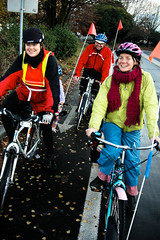Staffers and volunteers working on the City of Portland’s Bicycle Master Plan update are currently putting on a full-court press to finish what they hope will be the most ambitious and innovative plan of its kind in the country (much like our current one was when it came out in 1997).
Part of that massive effort (which I’ll be sharing more about in future stories) is the creation of new materials that help flesh out the case for biking in Portland. Skimming through the City of Portland’s website the other day, I came across one such document (I assume it will be used in the upcoming Bicycle Master Plan open houses in May).
The one-pager is titled “Why should the City of Portland invest in bicycling?” (download PDF below). It lays out many intelligent, compelling, and important justifications to promote (and pay for) better biking conditions.
I’ve reprinted it below:
Why should the City of Portland invest in bicycling?
The role of the modest bicycle in tackling the great challenges we face, today and tomorrow, and why bicycling is a vital tool in realizing the Portland we envisionIn Portland, bicycling is more than just a recreational pastime. It is the City’s fastest growing means of
transportation. In the last four years annual growth in bicycling has been exponential! In 2008, more than one of every six Portlanders used a bicycle as either their primary or secondary means of transportation to work. Here’s how bicycling can help Portland achieve some key goals identified in the Portland Plan:CLIMATE CHANGE & THE ENVIRONMENT – a city that is resilient in the face of climate change and has a minimal carbon footprint
Forty percent of Oregon’s CO2 emissions are attributed to transportation, which is also the fastest rising source. Bicycling can efficiently serve the fifty to sixty percent of trips in Portland that are 3 miles long or less. The draft City/County Climate Action Plan calls for a 30% commute mode split for bikes by 2030.AFFORDABILITY & ACCESSIBILITY – an affordable city with changing demographics and access for all to services and resources
Bicycling is the most equitable and affordable form of transportation. Every year the City expands and enhances what is already an extensive 274-mile network of bikeways. Portland bikeways connect important neighborhood, civic and employment destinations while providing seamless links to regional transit.HEALTH & SAFETY – a city that enhances human health and safety, promotes active lifestyles and safe routes to schools and neighborhood destinations
The Center for Disease Control says that “automobile trips that can be safely replaced by walking or bicycling offer the first target for increased physical activity in communities.” In Portland, the bicycle crash rate has declined as the number of bicyclists has grown. Studies suggest that getting more people cycling instead of driving helps make everyone safer!PROSPERITY – a prosperous city, building on our competitive strengths and our core values of equity and sustainability
Portland’s “green dividend.” identified by local economist Joe Cortright, annually keeps $800 million
circulating through the region’s economy that would leave the region if Portlanders drove as much as the U.S. average. In 2006, bicycle-related economic activity contributed an estimated $100 million to the city’s economy, along with 600 to 800 jobs. Portland’s “platinum-level” bicycle-friendly reputation attracts tourists as well as bike-oriented businesses.DISTINCT PLACES – a city that preserves the quality of our neighborhoods and creates other unique and livable places as we accommodate growth
Bicycles are distinctly Portland! Since bike trips are local in nature they enable interaction between
neighbors, strengthen the rider’s connection to the community, increase the likelihood of shopping locally, place more “eyes on the street”, and contribute to the sense of place.NEW WAYS & MEANS – a city that develops new ways of achieving public services and investments in a world of changing fiscal conditions
Investing in bicycle infrastructure is a cost-effective means to provide access and mobility. Despite spending less than 1% of Portland’s capital transportation budget over the past decade on bicycle expenditures, the city has seen dramatically increased ridership. Bicycling truly is Portland’s best transportation buy.
Any bike advocate in Portland worth a grain of salt should commit these tidbits to memory.
Now, anyone want to put all that on a t-shirt or poster?
— Download the PDF: Why should the City of Portland invest in bicycling? (112 kb)


